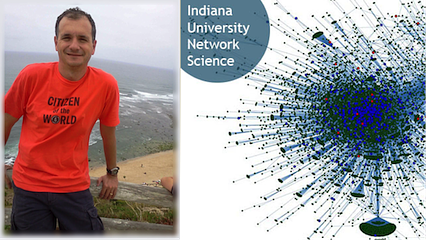
- Santa Fe Institute /
- 12 Mar 2015
In this post we feature complex systems scientist and professor Luis Rocha, of the School of Informatics and Computing at Indiana University. Luis directs the Complex Systems graduate program in Informatics. He has also served on the permanent staff at Los Alamos National Laboratory and has been part of the research community at the Santa Fe Institute. We asked Luis about his interests in Network Science and about the new Network Science Institute being formed at Indiana University.
Q: What is network science?
A: Network science is a set of methods for studying systems with many variables and interactions. Mathematically, network science started with graph theory, in which one simplifies a complex system into a network (or graph) that represents the system’s interactions as static links between variables: you remove all dynamics and just study the static interactions.
Q: What are the most interesting areas of research currently underway in network science?
A: One big thread is neuroscience. Both the United States and Europe have put a lot of resources lately into understanding the human brain. We know that neurons are connected to one another in networks, but we still don’t know how the signaling processes on these networks produce dynamical behavior that give rise to cognition. Here’s a quintessential problem: how does network structure constrain the dynamics of the brain that produce cognition? I think that is an exciting area where there’s a lot of research. Another thread that has generated a lot of interest lately is what people call computational social science. In that field, researchers look at how groups of people interact with one another, for instance, on social media. For example, this kind of “big-data” research has helped in understanding political processes, by collecting data on how people post on social media about political topics and then making inferences from that large-scale data.
Q: Can you tell me a little bit about the new Network Science Institute at Indiana University?
A: It’s brand new. For a while now Indiana University has had one of the largest contingents of faculty working in complex systems and, in particular, complex networks, but they have been spread out many different departments. I am in the School of Informatics and Computing and we have a strong contingent there, but we also have people in brain science, such as Olaf Sporns, and people in social science such as Stan Wasserman and Bernice Pescosolido. We were able to show to the president of IU that other universities are creating Network Science centers, but that we actually have more faculty working in these areas than these other universities. Our university president put a lot of money into creating this institute. The co-directors are Olaf Sporns, who is a very famous computational neuroscientist, and Bernice Pescosolido, who works in social science—social networks in particular. The institute will bring under the same umbrella all these people who were already doing network science and complex systems. And we’re hiring more such people!
Q: What are the long-term goals of the Network Science Institute?
A: The center has three main focus areas: neuroscience, computational social science, and biomedical applications. One example of a biomedical application of network science is understanding networks of drug interactions. Especially these days, as the US population ages, most people over a certain age are on a regimen of many drugs. It’s often not well understood how these drugs interact in the body. My own research group is working on this problem by doing a large-scale network analysis of both molecular experimental data and epidemiological data that we can infer from social networks. For this project we are helped considerably by research interactions facilitated by Indiana University’s network center. The center allows us to leverage what’s done in computation social science, but also what’s done at the molecular level. There is a potential to create some exciting research in this intersection that treats all these problems in a multi-level framework.
Q: What are your own research interests?
A: I originally started working in artificial intelligence and cognitive science, trying to model cognitive capabilities, but early on I realized that the problem is pretty complicated because brains are very complicated. I realized that understanding the emergence of collective behavior in simpler systems would be easier. So I focused on gene interactions in organisms—in particular how networks of genomic regulation give rise to phenotypes. I’ve also been working on the more general problem of how to automatically recognize and remove redundancies from network models of complex systems. Such redundancies can be at the level of unnecessary connections or dynamical transitions. The methods that I’ve been developing turn out to be applicable in a lot of areas—not just gene regulation networks. I recently started collaborations at the IU Network Science Institute applying some of these methods to social networks and brain networks—so I’m back working on topics that got me started in complex systems!
Q: Can you say more about this question of “removing redundancies” in networks?
A: When you use networks to model biochemical regulation in cells, you realize that a lot of the transitions—links in the network—that we observe as viable are actually redundant. They’re irrelevant. A cell never uses them in its normal functioning.
But it’s important to point out that the redundancies are network effects. You can’t find them by just looking at local interactions. But when you look at the network as a whole, certain interactions become redundant. And that’s very exciting because it allows us to simplify very large models and be able to deal with multi-variate systems that we never thought we’d be able to simulate because they were too large. But after we remove this redundancy, we can.
Such patterns of redundancy seem to be inherent to complex systems. Other researchers have identified similar patterns of redunancy in a variety of different kinds of networks. My group has been developing methods that allow us to measure such patterns effectively, and that’s exciting.
